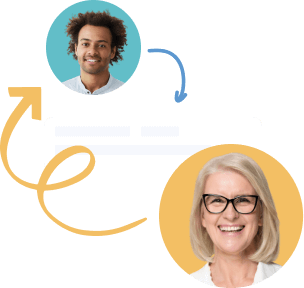Effective community engagement is powerful, but only a small percentage of the population participates in most planning efforts. So, what’s holding the public back? Once we understand the motivators and de-motivators alike, we can encourage more citizens to get involved.
Community engagement advances fairness and justice, legitimizes public decisions, and creates a common understanding of the vision of a place. It also incorporates the local knowledge of community members to help planners tackle big issues and craft successful solutions that are widely embraced.
However, community engagement practitioners often have limited staff resources, training, and money to fund public engagement methods. So, drawing broad cross-sections of the community into the planning process can be difficult. Naturally, the people who are most likely to participate often have vested interests in a plan and strong opinions. This can result in a combative and argumentative environment, a lack of overall support for the adopted plan, and disaffected citizens.
The flow-on effects can then snowball.
If people continue to be disappointed in the adopted plan, they will become more cynical and disillusioned about their participation having any meaningful difference. Over time, planning outcomes will start to too technical, abstract, and disconnected from their daily lives.
In the worst case, people don’t feel that their needs are being met and that outcomes are unfairly swayed towards those with the most interest and pull. When people continue to see lackluster solutions, they will start to feel disempowered, resulting in further disengagement and inaction.
How can we steer the ship in a more positive direction? We need to help the public to see that community engagement is a powerful process, rather than a tick-box exercise.
It’s essential that we understand how to tap into the extrinsic and intrinsic motivators that will encourage more community members to get involved. By understanding these motivators, we can therefore understand how to motivate community engagement and increase public participation overall.
Extend a Genuine and Personalized Invitation
There are many factors that can prevent someone from being able to participate in community engagement projects, including lack of time, transportation, and childcare. That’s why it’s essential that you meet people where they are and present them with a realistic and feasible avenue to participate. When you inadvertently exclude people from the decision-making process, their ability to provide public input is instantly minimized.
Suggesting a full-time worker attends a town-hall meeting at 10 am on a Wednesday morning isn’t going to be met with a lot of success. It might even be received as disingenuine.
It’s important to research your community members, think about their lives beyond census data, and devise an integrated communications strategy that will reach them before you start promoting your project.
Complacency is another significant participation barrier to overcome. If people feel generally satisfied with their community, there will be no sense of urgency to participate. And the public will rightly or wrongly believe that others can adequately address their concerns.
So, if you truly believe that your project is important, make sure that you craft a message that is relevant to the needs of your community.
Appeal to their individual problems and send a realistic yet optimistic message about how they can be addressed collectively. Also, think about whether you can use online technology to give them the means to participate throughout the project lifecycle.
Make People Feel Heard and Safe to Share
Nurturing an individual’s innate human need to feel useful and helpful is incredibly value. This is especially important if you’re trying to engage with someone who has a history of being ignored. It’s important to make people feel like they are safe to share their hopes and aspirations throughout the planning process.
Find simple ways to show genuine appreciation for a person’s contributions and hold guided discussions in safe and productive spaces with a commonality of purpose. Whether you’re hosting a moderated online forum or a face-to-face brainstorming session, skillful facilitation and creative approaches can help to bring out the best in people. Use practices and language that honor every participant’s individual and collective knowledge.
If you engage as early as possible, you can create space for an attitude of inquiry and exploration. By showcasing a willingness to learn, you will encourage people to open up. Remember that each individual is a powerful resource and convey that belief to them.
As you progress further into the engagement journey, you can then start to critically assess ends-and means-based values. Having these diverse insights out on the table allows you to take action. From here, engage consistently through fun, relevant, and productive conversation to earn a reputation as a community ally and create a receptive relationship with the public over time.
Showcase How Input Translates to Effective Outcomes
A history of unproductive meetings will make people feel cynical. Our biggest challenge is to showcase that we can translate dreams into appropriate action. If people feel like they have a degree of power over an outcome, they are far more likely to be interested in contributing their input. However, many community engagement processes are advisory, so it’s equally important to not overcommit yourself to delivering on every suggestion made.
Make the main game of the engagement clear and focus on generating thoughtful responses to systemic root issues that have been identified. Then it’s time to move the community forward toward a common goal. After gathering input from the community and observing their needs, you can work together to create solutions, test them out, and see how they work in the real world.
Be transparent and upfront with your community about how to be involved and the level of impact they can expect to have in the decision-making process. This will instantly help you gain long-term trust and buy-in from your community.
While the process may feel like an additional burden on time and resources, progressively building consensus will enhance outcomes and reduce the costs of implementation in the long run.
You can also use agile methodologies and online technology to make the process efficient. Cost-effective online stakeholder communications tools or a dedicated engagement page can also help you deliver timely progress updates to the community.
Staying In Touch and In Tune
When we make plans on behalf of our community, we’re often asking people to make significant changes in how they live. This process can run far more smoothly when people have had meaningful participation in preparing the plan and have an ongoing voice in assessing its efficacy.
Use the right communications plan and technology to meet citizens where they are. By connecting with their daily lives and honoring their input, you will gradually encourage more and more people to break out of their bubble.












